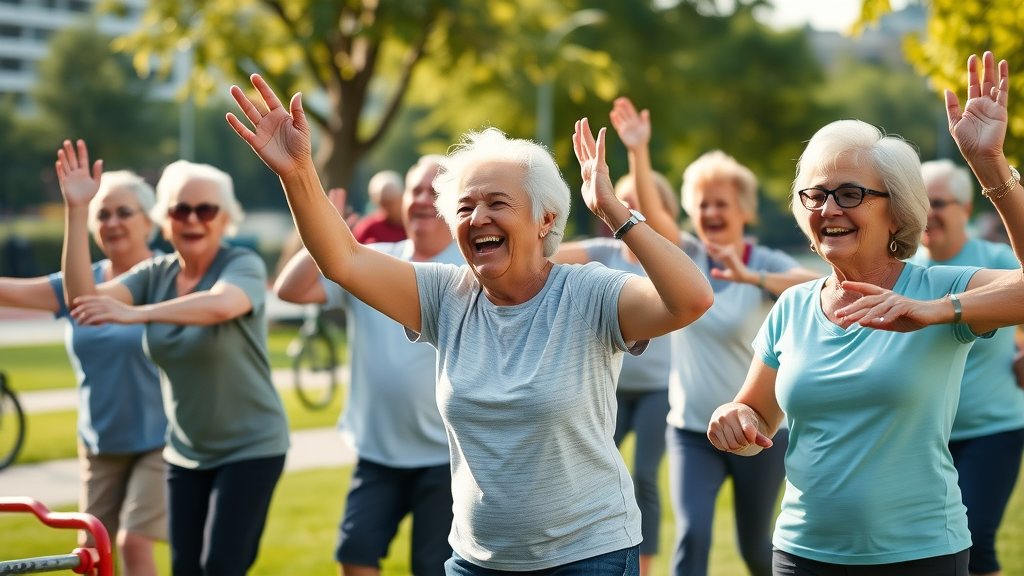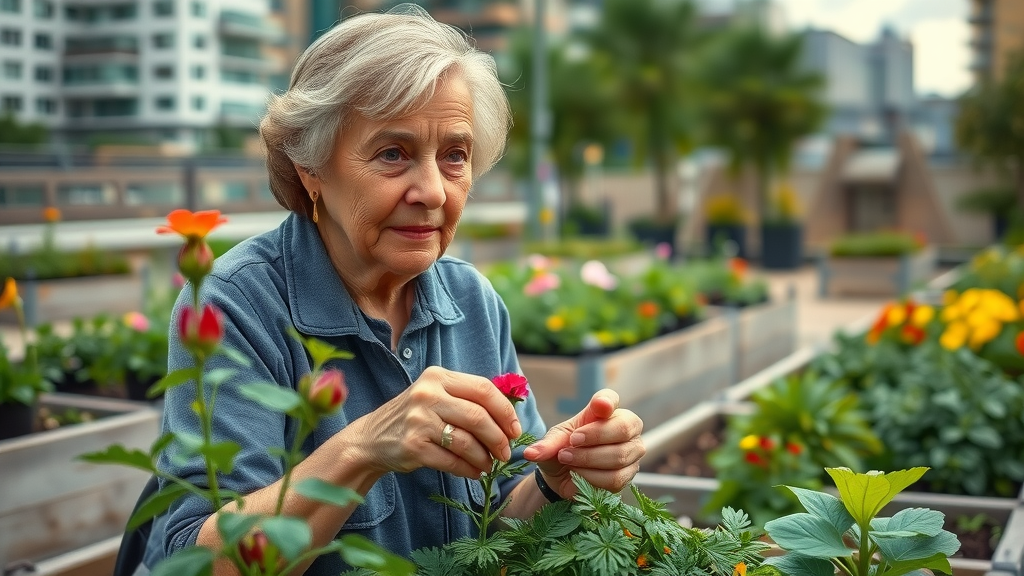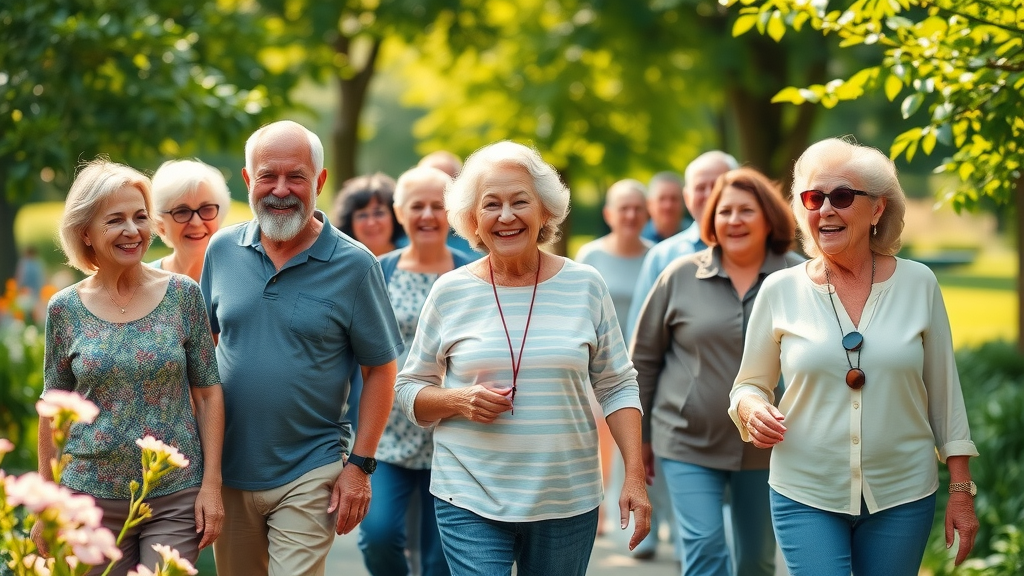"Studies show that only 1 in 10 older adults achieve the lifestyle factors most linked to longevity — revealing how much untapped potential there is for healthy aging and longevity."
Why Healthy Aging and Longevity Matter More Than Ever
In today’s rapidly evolving world, healthy aging and longevity are more than personal aspirations—they are public health imperatives. As the aging population grows, so do concerns about chronic diseases , rising healthcare costs , and the overall quality of life for older adults. Notably, research highlights that only a small fraction of people age with the habits that yield the longest, healthiest lives, indicating the vast potential for transformation.
Why should this matter to you and your community? Because healthy life means not just adding years to life, but adding life to those years. It means reducing the risks of heart disease , cognitive decline , and other chronic conditions such as cardiovascular disease —all of which weigh heavily on both individuals and healthcare systems. In the grand scheme, extending life is most meaningful if it comes with mental health and vitality, and this shift is prompting governments, healthcare organizations, and innovators to redefine what it means to age well.
With the tide turning toward prevention and early intervention , older adults can now access more resources than ever to support vibrant aging. The urgency of fostering healthy aging and longevity calls for us all to reflect on established habits and embrace proven, yet sometimes unconventional, strategies for lasting well-being.

What You Will Discover About Healthy Aging and Longevity
- Distinctions and connections between healthy aging and longevity
- Actionable habits and pillars that promote vitality in older adults
- Breakthroughs in public health advancing healthy aging
- Practical insights for integrating longevity strategies into daily life
- Competing interests shaping narratives about aging
Decoding Healthy Aging and Longevity: Terms and Trends
Defining Healthy Aging for Older Adults
To decode healthy aging and longevity , we must first understand their foundations. Healthy aging involves optimizing physical, mental, and social well-being throughout your entire life. This approach doesn’t simply focus on the absence of chronic disease, but promotes healthy lifestyle habits that support resilience and independence among older adults . A systematic review of public health outcomes shows that a healthy life depends on more than genes; it’s about protections against oxidative stress , regular physical activity, stress management, and mentally stimulating activities, all of which play roles in preventing accelerated aging.
In effect, healthy aging is about planning for later life so that people age with dignity, joy, and autonomy. It urges individuals and communities to extend the narrative beyond lifespan extension to encompass mental health, social connectivity, and purpose-driven living.
Longevity: Beyond Just Adding Years
Longevity, on the other hand, is often understood as the length of life or life expectancy . However, experts argue that healthy longevity isn't just about span extension. The goal should be to extend life for older adults while also maximizing their quality of life . True longevity means enjoying days filled with meaning, movement, and robust health, not merely counting the years. When we neglect this distinction, we risk promoting approaches that add years but fail to address chronic diseases, diminished cognitive function, or reduced mental health.
Today, with innovations in public health, medical advancements, and changing attitudes, older adults can pursue a healthy life that goes beyond numbers. Emerging trends show that combining traditional wisdom with innovative strategies yields significant improvements in health outcomes as people age.

| Term | Description |
|---|---|
| Healthy Aging | Optimizing physical, mental, social well-being across lifespan |
| Longevity | Extended duration of life, potentially without guaranteed quality |
Public Health Perspectives on Healthy Aging and Longevity
Advances in public health are transforming the future of healthy aging and longevity . Community-level programs now focus on the social determinants of health, such as access to safe environments, nutritious food, and opportunities for physical activity. Increasingly, public health officials prioritize health outcomes that support independence and reduce the burden of chronic diseases in an aging population.
Global innovations underscore the value of age-friendly cities—spaces that allow older adults to stay active, connected, and engaged. Early intervention measures are essential to promote healthy life and curb the rise of chronic disease. Policies encouraging walkable neighborhoods, accessible healthcare, and lifelong learning hold the key to both life expectancy and quality of life for older adults.
Importantly, public health advocates push for a shift from disease-centered care to prevention-focused strategies. These changes not only extend life but also make those extra years fuller and more engaged. Thus, improving health and longevity becomes a collective responsibility—one that benefits families, communities, and economies around the world.
While public health strategies are essential, individual lifestyle choices—such as exposure to natural elements—can also play a significant role in supporting healthy aging. For example, understanding the benefits of sunlight exposure for older adults can offer practical ways to enhance vitality and well-being as part of a holistic longevity plan.

The Five Pillars of Healthy Aging for Older Adults
- Physical health (activity, nutrition): Engaging in regular physical activity and maintaining a healthy diet reduce the risk of chronic and cardiovascular disease.
- Cognitive vitality: Pursuing mental stimulation and ongoing learning support cognitive function and brain health.
- Emotional connections and purpose: Fostering social engagement and a clear sense of meaning in life are essential for mental health .
- Environmental safety: Living in safe, accessible environments empowers older adults to remain independent and active.
- Access to healthcare: Timely healthcare and regular preventive checkups address health issues before they lead to chronic disease or reduced quality of life.
These five pillars are the foundation for strategies that promote healthy aging. By aligning daily habits with these elements, older adults can experience improved health outcomes, reduced risk of chronic diseases, and greater satisfaction as they age.
When public health initiatives encourage these pillars across communities, the result is not only lifespan extension but also a thriving, vibrant aging population empowered to pursue their passions and contribute to society.

Seven Keys to Longevity: My Perspective on Unlocking Vibrant Years
"Longevity without quality is an unfulfilled promise."
- Resilient mindset
- Consistent movement
- Social engagement
- Balanced diet
- Purpose-driven living
- Continuous learning
- Regular health checkups
As someone deeply passionate about healthy aging and longevity , I've discovered seven keys that open doors to vibrant, meaningful years. Cultivating a resilient mindset helps navigate life's inevitable changes and challenges, buffering against stress and its impact on health outcomes. Equally vital is consistent movement , which goes beyond reducing chronic disease risks; it restores energy, preserves independence, and improves both mental and physical health.
Social engagement brings joy, reduces the risk of cognitive decline, and bolsters a sense of belonging. Enjoying a balanced diet—rich in plants, healthy fats, and nutrients—combats oxidative stress and supports heart, brain, and immune health. But food alone isn’t enough; purpose-driven living fuels each day with motivation and meaning, reducing anxiety and giving direction even in later life.
Don’t underestimate the impact of continuous learning and regular health checkups . Lifelong curiosity protects cognitive function and provides daily enrichment. Meanwhile, health screenings allow for early intervention, catching potential issues long before they become major obstacles. These seven keys, woven together, unlock healthy longevity and maximize both lifespan and life satisfaction.

Healthy Aging and Longevity: New Strategies for Older Adults
Habit Stacking for Optimal Results
Many people struggle to build lasting habits, but “habit stacking” offers a creative solution. Habit stacking links new, positive actions (like daily stretching) to routines you already perform, such as brushing your teeth. This psychologist-approved method makes healthy changes easier and more sustainable for older adults seeking healthy aging and longevity. For instance, taking a brisk walk after morning coffee or doing light strength exercises while watching your favorite show gradually weaves wellness into the fabric of daily life.
Research shows that these small, incremental improvements compound over time, delivering big health benefits. When these habits are anchored to existing behaviors, they require less willpower to maintain. The simplicity of habit stacking allows older adults to progress toward long-term wellness with less stress, supporting both mental and physical health.
Ultimately, whether you’re hoping to prevent chronic disease or simply improve your daily energy, habit stacking can accelerate healthy aging. Public health experts increasingly recommend this approach, noting it supports not just lifespan extension but meaningful improvements in quality of life as people age.
Role of Technology in Supporting Healthy Aging
The emergence of digital tools and wearable devices has transformed support for healthy aging and longevity. Older adults can now track steps, monitor heart rate, record sleep quality, and even receive medication reminders from the comfort of home. This empowers individuals to take charge of their health and access real-time feedback that supports positive choices.
Technology also connects older adults with telehealth providers, educational resources, and social support groups, breaking down barriers to healthcare and continued learning. For those facing limited mobility or remote living situations, these resources can be the lifeline that promotes healthy longevity, reduces risk of chronic diseases , and fosters independence.
As tools become more accessible and user-friendly, technology will play a crucial role in ensuring older adults maintain optimal health outcomes, stay connected to loved ones, and continue to thrive in our digital age.

Competing Interests and the Narrative Around Healthy Aging and Longevity
"The story of healthy aging is shaped by who tells it—and why. Stay curious and critical."
Conversations and guidance around healthy aging and longevity are shaped by public health officials, commercial interests, academic researchers, and advocacy groups—each with their own priorities. Competing interests may influence which data is emphasized, which interventions are promoted, and even which definitions become mainstream. For example, supplement companies often highlight products as critical for healthy aging, while community-based organizations may argue for investment in social engagement and access to health care.
Carefully considering these competing interests matters. Older adults and their caregivers must sift through conflicting advice, distinguishing evidence-based strategies from marketing hype. Public health experts caution that no one-size-fits-all solution exists; what’s essential is a personalized approach that meets each individual’s unique needs and circumstances.
As we navigate this information-rich landscape, it’s critical to be both curious and discerning. Ask about the source of health claims and strive to balance convenience, efficacy, and proven strategy in seeking longevity and a healthy life.
Best Practices and Daily Habits for Healthy Aging and Longevity
- Prioritize sleep: Quality rest enables cellular repair and guards against accelerated aging .
- Stay socially active: Connection with others supports mental health and reduces risk of depression in older adults.
- Eat a plant-rich diet: A diet abundant in fruits, vegetables, and whole grains, combined with moderate proteins and healthy fats, can lower systemic inflammation and promote healthy life.
- Exercise consistently: Regular physical activity guards against chronic disease and helps extend life expectancy.
- Manage stress intentionally: Mindfulness, journaling, and deep breathing maintain emotional balance.
- Protect cognitive health: Engage in puzzles or memory games, read widely, and remain open to new experiences to keep your mind sharp.
- Have purpose and goals: Living each day with intent, curiosity, and purpose supports better health outcomes.
Incorporating these habits into your routine can dramatically influence how you age. When practiced collectively, they help guard against chronic diseases, preserve cognitive function, and foster joy and fulfillment. Public health research consistently underscores that daily habits have a greater impact on health and longevity than genetics alone.

People Also Ask: Healthy Aging and Longevity
What is the difference between healthy aging and longevity?
Healthy aging emphasizes maintaining physical, mental, and social wellness over a lifetime, striving for optimal quality of life as people age. Longevity focuses on extending the number of years lived, but this does not guarantee those years will be vibrant or free of chronic disease. Ideally, the goal is to pursue healthy longevity, which combines both concepts for a longer, more fulfilling life.
What are the 5 pillars of healthy aging?
The five pillars of healthy aging are: (1) Physical health through activity and nutrition, (2) Cognitive vitality, (3) Emotional connections and sense of purpose, (4) Environmental safety, and (5) Access to healthcare. By nurturing these pillars, older adults can optimize well-being and improve their health outcomes as they age.
What are the 7 keys to longevity?
The seven keys to longevity— resilient mindset , consistent movement , social engagement , balanced diet , purpose-driven living , continuous learning , and regular health checkups —provide a proven blueprint for extending both life span and health span. Integrating these into daily life promotes healthy longevity.
What is the #1 best habit for healthy aging?
While there are many habits that foster healthy aging, regular physical activity stands out as the single most impactful. Consistency in movement protects against chronic diseases, boosts mental health, and increases both lifespan and quality of life for older adults.
Frequently Asked Questions: Healthy Aging and Longevity
-
How do genetics influence healthy aging and longevity?
Genetics play a role in how individuals age, but studies show lifestyle factors—like diet, exercise, and social engagement—have a greater influence on quality and length of life than genes alone. Focusing on daily habits can help overcome many genetic predispositions. -
Do supplements genuinely improve health in later life?
While some supplements may help address specific deficiencies, most people can obtain necessary nutrients from a healthy diet. Public health experts recommend consulting with healthcare providers to determine personal needs and avoid overreliance on supplements. -
Can healthy aging start at any stage?
Yes, it’s never too early—or too late—to start prioritizing healthy aging. Research shows that adopting positive changes at any age can improve health outcomes, reduce risk of chronic diseases, and boost mental and physical health.
Reflecting on Lasting Vitality: My Final Thoughts on Healthy Aging and Longevity
"Healthy aging and longevity require both societal vision and personal action. Start today—your best years are still ahead."
As you continue your journey toward lasting vitality, remember that the path to healthy aging is both personal and ever-evolving. If you’re eager to dive deeper into real-life stories and advanced longevity strategies, explore how one woman’s experience reveals the secrets behind a thriving, extended life in this in-depth look at unlocking longevity . Discover actionable tips, inspiring perspectives, and the next steps you can take to make the most of every year ahead. Your commitment today can shape a future filled with energy, purpose, and fulfillment—embrace the possibilities that healthy longevity offers.
To further enhance your understanding of healthy aging and longevity, consider exploring the following resources:
- “Aging, longevity, and healthy aging: the public health approach” ( pmc.ncbi.nlm.nih.gov )
This article delves into the public health strategies essential for promoting healthy aging, emphasizing the importance of nutrition, physical activity, and preventive healthcare services.
- “Healthy Aging and Longevity” ( nia.nih.gov )
Provided by the National Institute on Aging, this resource offers comprehensive information on various aspects of aging, including tips for maintaining health and independence as you age.
If you’re committed to achieving lasting vitality, these resources will provide valuable insights and practical strategies to support your journey toward healthy aging and longevity.
 Add Element
Add Element  Add Row
Add Row 



Write A Comment